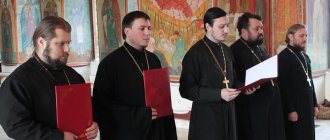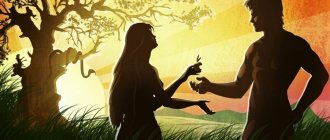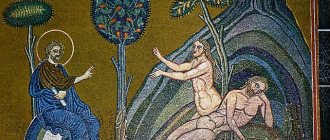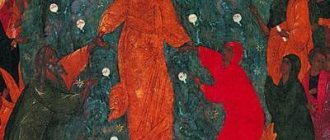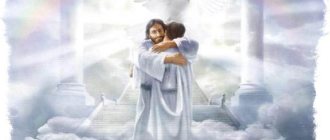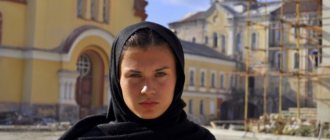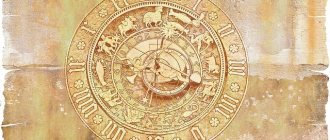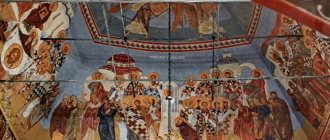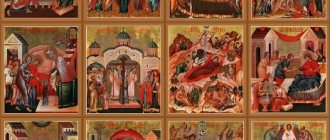Dr. Robert W. Carter
A surprise to many people is the fact that there is a huge amount of evidence that the entire human race descended from two people (Adam and Eve) several thousand years ago, and that in the recent past there has been a serious population decline (the bottleneck effect) during the time of the Flood, and that after this there was a unique scattering of people from one place (from the Tower of Babel). What surprises them even more is that most of this evidence comes from evolutionary scientists. A huge amount of evidence of biblical history has been found by modern geneticists. And this evidence is available to anyone who wants to study it!
The evolutionary map of the world's migrations is strikingly close to the biblical account of the dispersion of people from Babylon. The "out of Africa" evolutionary theory tells us that there was a single dispersal of people who were concentrated in one place and dispersed throughout the Middle East, creating three mitochondrial lineages, with people walking in small groups through previously uninhabited areas, and all this happened in a relatively recent past. Every point of this theory was directly predicted in the biblical story of the Babylonian dispersion. (Figure from www.mitomap.org).
For our purposes, the most important things to study will be the Y chromosome (which is found only in males and is passed directly from father to son) and mitochondrial DNA (the small DNA in mitochondria that we almost always inherit only from our mothers; men do not pass it on to my children). These two pieces of DNA contain some startling facts about our past.
Over the past ten years, a huge amount of information has been collected that will allow us to answer questions that we never dreamed of. The tools of modern genetics allow us to ask questions about history, too, because our genes carry information that reflects where we came from and how we became who we are today. And these tools at our disposal are amazing.
Creation and genetics
There are two brief passages in the creation account that we can use to help us reach some conclusions about human genetic history. Please note that we cannot use these same verses in the case of land animals (because we do not know how many of each species were created in the beginning) or in the case of marine organisms, which God created in abundance (Genesis 1:21). These statements apply only to people:
“And the Lord God formed man of the dust of the ground, and breathed into his nostrils the breath of life, and man became a living being” (Genesis 2:7).
“And the Lord God caused the man to fall into a deep sleep; and when he fell asleep, he took one of his ribs and covered that place with flesh. And the Lord God made a woman from the rib he had taken from the man, and brought her to the man” (Genesis 2:21–22).
These simple words have a huge meaning. They set limits on the diversity of people living today . The Bible clearly states that the human race began with just two people. But how different were these two people from each other? There is an intriguing possibility that Eve was a clone of Adam. The science of cloning involves taking DNA from one organism and using it to create a nearly perfect copy of the original. Here, God took a piece of flesh with cells, organelles, and most importantly, Adam's DNA, and used it all to create a woman. Of course, she couldn't be a perfect clone of Adam, because she was a woman! But what if God took Adam's genome and used it to create Eve? All he had to do was not take Adam’s Y chromosome, but double his X chromosome, and voila - the woman was ready!
I don't know if Eve was genetically identical to Adam. The only reason I bring this up is because, according to Scripture, we have only two possible versions of human genetic history: either one original genome, or two. In either case, this is very different from popular evolutionary models,2 but we should discuss all the possibilities allowed by the Bible.
Your genome is like an encyclopedia (almost literally). Like an encyclopedia, your genome is divided into volumes called chromosomes, with two copies of each volume (except for the X and Y chromosomes; women have two X chromosomes, while men have one X and one Y chromosome). chromosome). Now imagine that you compare two volumes with each other and discover that in each volume one word in a certain sentence is spelled differently (for example, “light” instead of “color”). You see, if Eve were a clone of Adam, there would have to be at most two possible variants in any given segment of the genome. However, if Eve were not a clone, there would be a maximum of four possible variants in any segment of the genome (because each of the original chromosomes would come in four copies). This allows for greater diversity , but limits the number of variations in one segment of the genome to two, three or four original reads.
Is this factual? Absolutely! Most variant regions of the human genome come in two versions, and these versions are distributed throughout the world. There are some highly variable segments that would seem to contradict this theory, but most of them arose as a result of mutations that occurred in various subpopulations after the Babylonian dispersion.
Almost all genetic variations in humans today could have been carried by just two people, if we do not take into account the mutations that occurred after humans dispersed across the globe.
There are indications that Eve may not have been a clone of Adam. The ABO blood type system is a typical example of how a gene can have more than two versions.3 There are three main versions of the blood type gene (A, B, and O). However, many, but not all, people with type O blood carry a substance that resembles a mutated element A (this mutation prevents the production of type A traits outside the cell). So we have a gene that comes in more than two versions, but one of the major versions is obviously a mutation. This is typical for many other genes, although, as usual, there are exceptions. The most important takeaway from all this is that virtually all of the genetic variation in humans today could have been carried by just two people, not counting the mutations that occurred as humans dispersed across the globe. This surprises many people.
Birth of first child
It is generally accepted that the firstborn of Adam and Eve was Cain, the future killer of his brother. Saint Philaret of Moscow believed that the first birth of Cain could be explained by the fact that by that time his parents had not yet had time to repent of the sin they had committed. After all, at the time of the birth of the eldest son, the first people had already been expelled from paradise. Nevertheless, Eve was so pleased with the child that she exclaimed: “I have obtained a man from the Lord” (Gen. 4:1). And although many believe that the name “Cain” comes from the Hebrew verb “to acquire,” this is not entirely correct. More often, researchers are inclined to mean the name “Cain” as “blacksmith” - this is exactly what this word sounds like in Aramaic and Arabic. And yet, if we believe that Eve actually found happiness in the person of the son she gave birth to, then why didn’t she follow God’s call and give birth to children earlier, before being expelled from paradise?
Flood and genetics
Like the creation story, the Flood account has only a few verses to help us create our model. But as we have seen before, these verses are of great importance.
About 10 generations after creation, there was a severe and rapid decline in the human population (the bottleneck effect). From countless numbers of people, the entire world population was reduced to just eight souls , among whom there were only three couples of reproductive age.
“And Noah and his sons and his wife and his sons’ wives with him entered into the ark from the waters of the flood.” (Genesis 7:7)
“The sons of Noah who came out of the ark were Shem, Ham and Japheth. Ham was the father of Canaan. These three were the sons of Noah, and from them the whole earth was peopled.” (Genesis 9:18–19)
From these statements we can draw several important conclusions. For example, based on Genesis chapters 7 and 9, how many Y chromosomes were on the ark? Answer: one . Yes, there were four men, but Noah passed on his Y chromosome to all of his sons. If no mutations occurred (and this is quite possible), each of his sons had the same Y chromosome. We don't know how many mutations occurred before the flood. Given the long lifespan of our pre-Flood ancestors, it would be reasonable to assume that mutations were rare, but the entire creation, including the human genome, was cursed, so it would be unreasonable to conclude that there were no mutations at all before the Flood. The number of mutations is a matter of debate, but if they occurred, the Flood should have wiped out most traces of them (and all traces in the case of the Y chromosome).
How many lines of mitochondrial DNA were there on the ark? Answer: three. Yes, there were four women on the ark, but the Bible does not mention that Noah's wife had any more children (in this case, girls) after the flood. Now notice what it says in Genesis 9:19: “These three were the sons of Noah, and of them was the people of all the earth.” This is a strong indication that Noah's wife did not introduce new inhabitants into the population of the earth. Since there was no prohibition against sibling marriage at that time,4 one or more of her daughters-in-law could have been her daughters, but this does not change the fact that, at first glance, we should expect to see a maximum of three mitochondrial lineages in modern population of the earth. There is a possibility that there would be fewer if there were few mutations before the Flood, or if several of Noah's daughters-in-law were related by blood to his sons. At most, we expect to see no more than four such lines.
How many lines of X chromosomes were there on the ark? The answer to this question is ambiguous. If you count everyone together, there were eight of them. If, by chance, Noah's wife passed on the same X chromosome to all three of her sons (and this probability is 25%), then there were seven of them. If Noah had another daughter after the Flood (unlikely, but still possible), then there could even be nine lines of X chromosomes. In any case, this is a sufficient amount of genetic material. And because women's X chromosomes recombine, we potentially have an enormous amount of genetic information included in the world's X chromosomes.
Are these conclusions consistent with the factual evidence? Absolutely! It turns out that Y chromosomes are similar to each other all over the world . As evolutionists claim, no “ancient” (i.e., highly mutated or altered) Y chromosome has been found.5 This confused evolutionists, and they were forced to put forward the idea of higher “reproductive variation” among males compared to women, the high level of "genetic preservation" on the Y chromosome, or the possible "selective purge" that wiped out all other male lines.6 For the biblical model, this is an excellent fit, and we can accept it as is.
It turns out that there are three major mitochondrial DNA lineages throughout the world.
The mitochondrial DNA evidence fits our model just as clearly as the Y chromosome evidence. It turns out that there are three major mitochondrial DNA lineages throughout the world . Evolutionists call these lines the letters “M”, “N”, “R”, so we use the same names. However, evolutionists do not want to admit that these lineages descended from the people on the ark. They claim to be derived from ancient ancestral lines of the African continent, but such claims are based on unsupported speculation. (I discussed this issue in detail in my recent article published in The Journal of Creation 7.) It also turns out that the M, N, and R lines differ from each other by only a few mutations. This indicates the number of mutations that occurred during the generations before the Flood.
Let's say, for example, that there were ten generations from Eve to the women who entered the ark. Lines M and N are separated from each other by about 8 mutations (in total there are about 16,500 letters in the mitochondrial genome). The R line is only one mutation away from the N line. This indicates mutation pressure that occurred before the flood. Assuming that mutations occur at the same frequency in all lineages, the M and N lines are separated from Eve by an average of four mutations (maybe four mutations in each lineage per ten generations). What about the R line? It is very similar to the N line. Were N and R sisters, or were they related by closer blood ties than to M? We will never know, but it will be quite exciting to think about.
Another line of evidence comes to light when one considers the amount of genetic diversity around the world. In fact, much less diversity was found than most scientists (i.e. evolutionists) predicted. In general, the lack of diversity among humans is the reason why the “out of Africa” evolutionary model teaches that humanity went through a catastrophic bottleneck that led to near extinction. As a result, only about 10,000 (or even 1,000) survived.8 However, the reason for the lack of such diversity is twofold. First, the human race began with just two people. Secondly, the human race is not that old, and has not yet accumulated a large number of mutations, despite their high frequency. Thirdly, the event that provoked the “bottleneck” effect really took place - it was the Flood of Noah’s time!
The mystery of the disappearance of the Neanderthals
So what is this destruction program that turned on during a certain period of time?
Here it should immediately be noted that the Neanderthals were far from alone in their tragedy.
Many representatives of the animal world sunk into eternity just 30-10 thousand years ago. As an example, we can cite the same mammoths that disappeared from the planet without a trace for unknown reasons.
Science today cannot explain this phenomenon.
There are a number of concepts that claim absolute truth, but there is no single theory that can objectively reflect the entire range of contradictions and focus it in a single and coherent system based on absolute and error-free evidence.
The process of extinction of the Neanderthals took more than one thousand years. Their population increased and decreased.
In the end, people disappeared, unconditionally giving way in the sun to those more successful and adapted to harsh and rational reality.
The mystery of the disappearance of this human species may lie in areas far from official science.
Maybe Neanderthals found an entrance to other worlds, to other dimensions. Having left the existing reality, they are now thriving in a different reality: they are developing, improving, and even surpass modern people in terms of the level of scientific and technological progress.
Living in the sublunary world, the mighty strong men, just like the slender Cro-Magnons, dreamed, loved and daily fought for their survival on planet Earth.
They have sunk into oblivion, but, in any case, had a certain impact on the ancestors of modern man.
Who knows, maybe some positive or negative character traits inherent in those living today are a derivative of the psychological type that the Neanderthal was.
All this is just guesswork and speculation. The essence of the problem is that ineradicable human curiosity will ultimately play a positive role in this matter.
The secret will become clear, and current generations, and maybe their immediate descendants, will finally learn the whole truth about their distant relatives.
Based on materials from foreign publications
Tower of Babel and genetics
The story of the Tower of Babel has been a favorite children's story for generations. But maybe this is something more than a fairy tale? Is it possible that there is evidence to support this narrative of riot and judgment? As with the biblical account of creation and the flood, there are only a few verses that apply to our model of genetics. They are very simple.
“The whole earth had one language and one dialect.” Genesis 11:1
“And they said, Let us build ourselves a city and a tower, its top reaching to heaven, and let us make a name for ourselves, before we are scattered over the face of all the earth.” Genesis 11:4
It sounds like they had a homogeneous culture, but what did people do in this situation? Would one expect that they could mix freely? Were there language or cultural barriers that prevented the sons of Shem from marrying the daughters of Japheth? Could the daughters of Ham freely marry the sons of any of these three men? Notice that Genesis 11:4 says that they knew about the possibility of scattering and separation from each other and deliberately did the opposite! This was contrary to the direction of God, who told them to disperse (to repopulate the earth). So He took matters into his own hands.
“Let us go down and confuse their language there, so that one does not understand the speech of the other. And the Lord scattered them from there over all the earth; and they stopped building the city.” Genesis 11:7-8
There are several great lessons to be learned from this story of the Babylonian dispersion. First, it explains the amazing cultural connections between ancient peoples - for example, the building of the pyramids, similar flood legends, and ancient non-Christian theologies that connect many people with biblical figures (for example, many of the royal dynasties of the pagan countries of eastern Europe are descendants of Japheth, the son of Noah9 ).
The sharp increase in the world's population over the past few decades is a well-known fact. From a biblical perspective, the modern human population fits easily into the standard model of population growth using conservative parameters.10 In fact, if we take six people as a starting point and assume that the human population doubled every 150 years, we get the current world population (at a growth rate of less than 0.5% per year!) The population size must have increased rapidly, given the speed with which the world's population after the flood revived agriculture, animal husbandry, fishing and civilization. So we must ask the question: “Why are there so few people in the modern world?” The answer is that the world is young, we have only lived on earth for a few thousand years .
When did the dispersal occur? The best clue to answer this question is found in Genesis 10:25. In the fifth generation of Shem's descendants, one of the sons was given the name Peleg because "in his days the earth was divided." What does this indicate? Many people believe that we are talking about the division of land (plate tectonics). This may be true, but it would require a lot of geological activity after the Flood and it would have to have happened in historical times, and there are no records of such events. I like a slightly different interpretation: this passage refers to the division of nations in Babylon. A few verses after the mention of Peleg, there is another mention of division in Babylon. And such an interpretation fits both into the context and into the scientific data. In this context, Peleg was closely associated with Babylon.
How large was the population at that time? One would expect the population to grow rapidly, but we know nothing about this for sure. The Bible names 16 sons born to three brothers - Shem, Ham and Japheth. Assuming they had about the same number of daughters, Noah could have had about 30 grandchildren. At this rate of growth, there were about 150 children in the generation of Sal, about 750 children in the generation of Eber, and about 3,750 in the generation of Peleg. Of course, these generations overlap with each other, so let's say that during the time of Babylon there lived from 1,000 to 10,000 people. This fits perfectly with existing data. This is a fairly high growth rate, but wars and diseases were just about to begin.
There is another verse in this section that we should discuss:
“These are the tribes of the sons of Noah, according to their genealogy, among their nations. From them the nations spread throughout the earth after the flood.” Genesis 10:32
In Babylon, God did not divide the nations by language. He used different languages to divide people along the patrilineal line! This fact is of extreme importance and is the key to understanding the genetic history of mankind.
Do you see the implications of this verse? In Babylon, God did not divide the nations by language. He used different languages to divide people along the patrilineal line! This fact is of extreme importance and is the key to understanding the genetic history of mankind. Paternal separation would have resulted in the formation of specific Y-chromosomal lineages in different geographic areas . Since men and women from the three main families could communicate freely with each other before this event, this also led to the mixing of mitochondrial lineages. It was as if God put all the people in a giant spreadsheet and pressed the “sort by father” button. Then he took this list and used it to divide the nations.
We have already seen that there is little variation among the Y chromosomes. Now add to this the fact that this small amount of variation is almost always characteristic of a particular geographic region. This means that after peoples were divided according to their Y chromosome, mutations occurred in various family lines. And since different ancestral lines were sent to certain geographic areas, certain mutations became characteristic of certain geographic regions . And the modern spread of Y-chromosomal lineages is a powerful confirmation of the biblical model.
The modern spread of Y-chromosomal lineages is a powerful confirmation of the biblical model.
Mitochondrial DNA provides further evidence. We already know that there are three main lineages of mitochondrial DNA. Now let's add to this knowledge the fact that these three lines are randomly scattered throughout the world. In addition, the different mutations in each of these three families of mitochondrial DNA are also specific to different geographic regions.11 In other words, as these three admixed mitochondrial lineages spread along with the spread of the Y chromosome, each of these lineages in each region underwent new mutations, as we might have expected.
Biological characteristics of the Neanderthal organism and lifestyle
Maybe the answer lies in the biological characteristics of the Neanderthals? The maximum lifespan of an individual did not reach 50 years. By this time he was turning into a decrepit old man.
The heyday of life activity occurred in the period from 12 to 35-38 years. It was at the age of 12 that the Neanderthal turned into a full-fledged man, capable of childbearing, hunting and performing other social functions.
Only a few reached old age. Almost half of Neanderthals died before reaching 20 years of age.
Approximately 40% left this mortal coil between the ages of 20 and 30. The lucky ones lived mostly until they were 40-45. Death always went hand in hand with paleoanthropes and was a familiar and commonplace thing.
Numerous diseases; death while hunting or in skirmishes with other tribes; the sharp teeth and claws of predatory animals mowed down these representatives of the hominid family in the thousands.
Women gave birth every year and by the age of 25-30 they turned into old women.
In their physical development, they were inferior to men, having a more flimsy constitution and shorter stature, but in endurance they had no equal, which once again emphasizes the rationalism and sanity of nature.
Neanderthal tribe
Neanderthals lived in small groups of 30-40 people . It is human, since according to the generally accepted classification they belong to the genus of people, and their appearance is Neanderthal man.
Each group had a leader - a chief. He took upon himself all the care of the members of his small community. His word was law, failure to comply with orders was a crime.
Only the leader had the right to divide the game obtained from the hunt. He took the best pieces for himself and gave the slightly worse ones to young hunters. The mature and weak, as well as women and children, received the rest.
Strength was respected in this public education, but the weak were not oppressed, but were supported in every possible way and given work according to their strength.
This indicates certain moral principles, high consciousness and the beginnings of humanism.
The dead were buried in shallow graves. The human corpse was laid on its side, the knees were pulled up to the chin.
A stone knife, some kind of food, and jewelry made from multi-colored pebbles or teeth of predatory animals were left nearby.
The burial places were not marked in any way, or maybe something was done, but merciless time destroyed and destroyed everything.
This is how Neanderthals were buried
The diet of Neanderthals was not very varied. These representatives of the human race preferred meat to all other foods.
Mammoths, buffaloes, cave bears - this is a list of those animals that were hunted with great skill and art by adult and strong members of the community.
Popular articles: 6 grand illusions, modern slavery.
The weaker and younger caught small animals, but did not favor birds, giving priority to rodents and wild goats.
Neanderthals did not like fish either. They ate it only in difficult times, since hunger is not a problem, and in the absence of fish, as you know, fish also eat cancer.
However, here it should be noted that they did not disdain human flesh. At the ancient sites of these people, bones of not only mammoths and buffaloes, but also Cro-Magnons are often found.
For the sake of reference, it should be noted that the latter are also far from angels. Cro-Magnons also ate Neanderthals, apparently considering such gluttony to be commonplace.
To become fully acquainted with representatives of this species, it is necessary to touch upon their habitat. Neanderthals lived mainly in Europe . Their favorite place is the Iberian Peninsula.
In second place is probably the southern part of France. There were much fewer Neanderthals in Germany, but they happily settled in the Crimea and the Caucasus.
The Middle East also did not escape the attention of these ancient people. They also inhabited Altai; their settlements are also found in Central Asia.
But the main concentration was in the Pyrenees. Two-thirds of all Neanderthals lived here. These were their lands, on which the Cro-Magnon foot did not dare to set foot.
The latter made up for such a loss with other territories, making the Apennine Peninsula their ancestral fiefdom.
In the rest of Europe, Neanderthals and Cro-Magnons lived mixed together. It cannot be said that it was a friendly neighborhood.
Numerous bloody skirmishes between representatives of the same biological species were common.
The weapons used by the Neanderthals were a club and a stone knife sharpened on both sides.
They handled these simple objects very skillfully. Both on the hunt and in skirmishes with enemies, the same club was a reliable means of both defense and attack.
A group of short, powerful, strong men was a formidable military formation, capable of not only defending itself, but also attacking, sending the same Cro-Magnons to a shameful flight.
The latter were much taller than the Neanderthals: their height reached 185 cm, but this achievement did not help much. The ancestors of modern man had long legs, arms, a muscular body, but all this was not distinguished by massive forms.
Neanderthal and Cro-Magnon
The Cro-Magnons were inferior to the Neanderthals in their physical development. In terms of dexterity, speed of reaction and mental development, they were equal. As a result, force won.
The distant ancestors of modern man either retreated or died, and the mighty little men celebrated their victory by eating the bodies of their killed enemies. They communicated through short phrases or individual words.
The speech of the Neanderthals was indeed not distinguished by eloquence, and the sentences consisted of two or three words . This did not mean that ancient people gravitated towards silent contemplation of the world around them and possessed a great gift - the ability to listen to others.
Everything rested on the structure of the nasopharynx and larynx. It is in the larynx that the voice apparatus is located, thanks to which you can talk long and eloquently about completely different things, impressing those present with your extensive knowledge and original way of thinking.
The structure of these most important organs did not allow the powerful, robust men to utter long, ornate phrases.
Nature deprived them of such opportunities from birth, which cannot be said about Cro-Magnons. Everything was fine with their speech. However, you can easily verify this by looking at those around you.
Could underdeveloped speech be the reason for the extinction of a huge number of people? Hardly. The same monkeys feel great in a harsh and dangerous world, without possessing the proper art of verbose communication.
And the Neanderthals themselves lived for almost 300 thousand years, transmitting information through individual words or short phrases. All this time they coexisted quite comfortably and understood each other perfectly.
After the Flood
The last significant reference in the Bible that will help us build our model of genetic history is called the “table of nations.” It is found in Genesis chapters 9 and 10. The table is a written listing of the tribes after the Babylonian dispersion, from whom they came, and where they went. If the Bible is a reliable historical source, we would expect to find significant evidence for a table of peoples in the genetic information. However, the truth is not that simple, and it is important to keep a few things in mind. Firstly, this entire narration was written down by a Middle Eastern man of Eastern minorities. It is incomplete in the sense that there are parts of the world that were not discussed at that time (part of Africa south of Safari, eastern Europe, most of Asia, Australia, both American continents and Oceania).
The table was compiled after the dispersal began, but is unlikely to be after the dispersal was completed. In fact, a lot has changed in the intervening years. Groups of people migrated, cultures died out, languages changed, separate cultures merged, etc. The history of mankind is full of ups and downs - people mixed with each other and fought, resisted invasions and experienced conquest. The history of mankind since the Babylonian dispersion is very complex. Modern genetics may answer some major questions, but we may never find answers to more minor questions.
This is a very important theme for the creation model. The world does not view the Bible in a very positive light. In fact, the world treats her with disdain or even outright hatred. Attacks on the Bible are often based on the fact that the Bible is not historically reliable. And if the Bible is not accurate from a historical point of view, then what can we say about theology? Think about what Jesus said to Nicodemus in John 3:12: “If I told you earthly things and you do not believe, how will you believe if I tell you heavenly things?” Many people today do not see the story in the Bible, so its spiritual meaning is not important to them. What would happen to the Gospel if the story told in the Bible turned out to be true?
Conception before exile
Scripture says that the Creator ordered the first people to populate the earth. St. Basil the Great argued that this call of God can be explained by the fact that his “creation was aimed at many people,” and not just the first couple. Thus, it turns out that the Lord really wanted Adam and Eve to give birth to new people.
In fact, it is difficult to imagine that Adam and Eve disobeyed the Lord even before the appearance of the tempting serpent and did not fulfill God’s covenant to reproduce. Otherwise, it most likely would have been mentioned in the Bible. As a result, it can be assumed that Eve was already carrying a child under her heart when the Lord kicked her and Adam out of paradise. A similar version was voiced by Professor of the Moscow Theological Academy, Protodeacon Andrei Kuraev in an interview with Rossiyskaya Gazeta (No. 6172).
Links and notes
- Nelson J. W. Genetics and biblical demographic events. Journal of Creation 17(1):21–23, 2003; https://creation.com/genetics-and-biblical-demographic-events Return to text.
- According to the most common version of the "out of Africa" theory, humans (Homo erectus) have lived in Africa for about a million years. Several tens of thousands of years ago (and this date varies depending on the author), a dramatic bottleneck effect caused the human population to decline to 10,000 or less. Modern humans emerged from this bottleneck, our population grew and changed little by little, and then we left Africa and settled in colonies in various parts of the world. Return to text.
- Criswell D. ABO blood groups and human origins. Actions and Facts 37(2):10, 2008; ; and also an article by J. Sarfati. “Blood groups and their origin” (Response to criticism). Creation Journal (later CEN Technical Journal) 11(1):31–32, 1997. Return to text.
- The prohibition against marrying within one's immediate family was first given in Leviticus 18 and 20, approximately 2,500 years after creation. And in fact, Abraham, Isaac and Jacob married their closest relatives from their own family. Return to text.
- Joblin MA, Tyler-Smith C. The human Y chromosome: an evolutionary marker reaches maturity. Nature Reviews 4:598–612, 2003. Return to text.
- Garrigan, D. and Hammer, M.F. Reconstruction of human origins in the era of the genome. Nature Reviews 7:669–680, 2006. Return to text.
- Carter R.W. The neutral model of evolution and the recent origin of Africans. Journal of Creation 23(1):70–77, 2009. Return to text.
- Harpending H.S. and others. Genetic structure of ancient populations. Modern anthropology. 34:483, 1993. Return to text.
- A series of five articles on the topic was published in the Journal of Creation (later CEN Technical Journal) in the early 1990s. See Cooper W.R. Early history of man: Part 1. Table of nations. CEN Tech J 4:67–92, 1990. Return to text.
- Batten D. Where are all these people? Creation 23(3):52–55, 2001; creation.com/where-are-all-the-people. You can do the simulation yourself in a spreadsheet using the formula N = Noekt, where No = initial population size (6), k = annual growth rate (experiment with different rates and see what happens), and t = time (in years) . Return to text.
- Torroni A., et al., Reaping the Fruit from the Human Mitochondrial DNA Tree, TRENDS in Genetics 22(6):339–345, 2006. Return to text.
Source - www.creation.com
To this assumption, back in the 90s, science said a categorical “no”.
Scientists examined the mitochondria of modern humans and a similar molecule taken from the remains of a Neanderthal. There was nothing in common between them.
Mitochondrial DNA is passed on only from the mother and remains virtually unchanged for thousands of years.
It follows that all humanity descended from one progenitor (mitochondrial Eve).
The short, sturdy ones turned out to have a completely different foremother, who gave life to the first of them many, many thousands of years ago.
Decades flashed by, centuries passed, millennia slowly crawled into eternity. Neanderthals lived, reproduced, and hunted.
They managed to survive the difficult times of the ice ages, of which there were three. They did not squander their originality and strength in the beneficial times of interglacial periods.
And suddenly they all died as one, leaving no traces of themselves as a reminder.
First, this human species disappeared from the lands of Germany, then France and the Middle East.
The Cro-Magnons settled firmly in the above-mentioned areas. Not only did they not become extinct, but on the contrary, they actively began to multiply, gradually moving further and further to the East.
Neanderthal settlements remained only in the Pyrenees. This was their original place. It was from here that they began their journey, gradually settling in Europe and nearby areas of Asia.
Their individual communities even reached Altai and Central Asia.
The last stronghold served the mighty strongmen as reliable protection. They stayed on their native peninsula for another whole millennium.
True, the remaining five centuries before their disappearance, the lands dear to their hearts had to be shared with the shameless Cro-Magnons. They very quickly settled in the Pyrenees and began to crowd out the original owners.
The path of evolution of Cro-Magnons and Neanderthals
Cohabitation was characterized by outbreaks of hostility and long periods of peace. The end was fatal for some and prosperous for others.
The last Neanderthals disappeared 27 thousand years ago . The Cro-Magnons, having changed slightly in appearance, are still thriving. They are actively reproducing - their number has already exceeded 6 billion.
